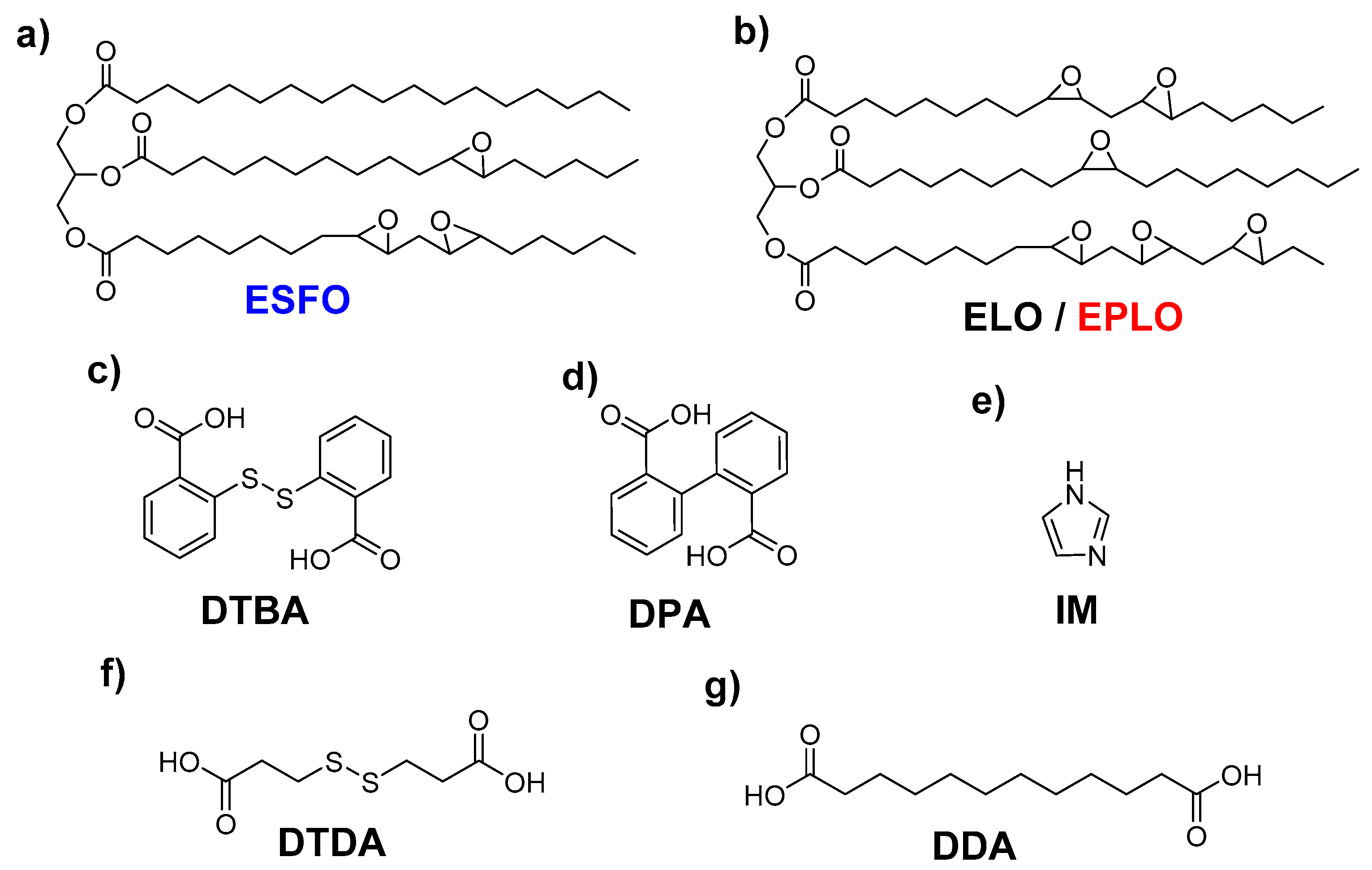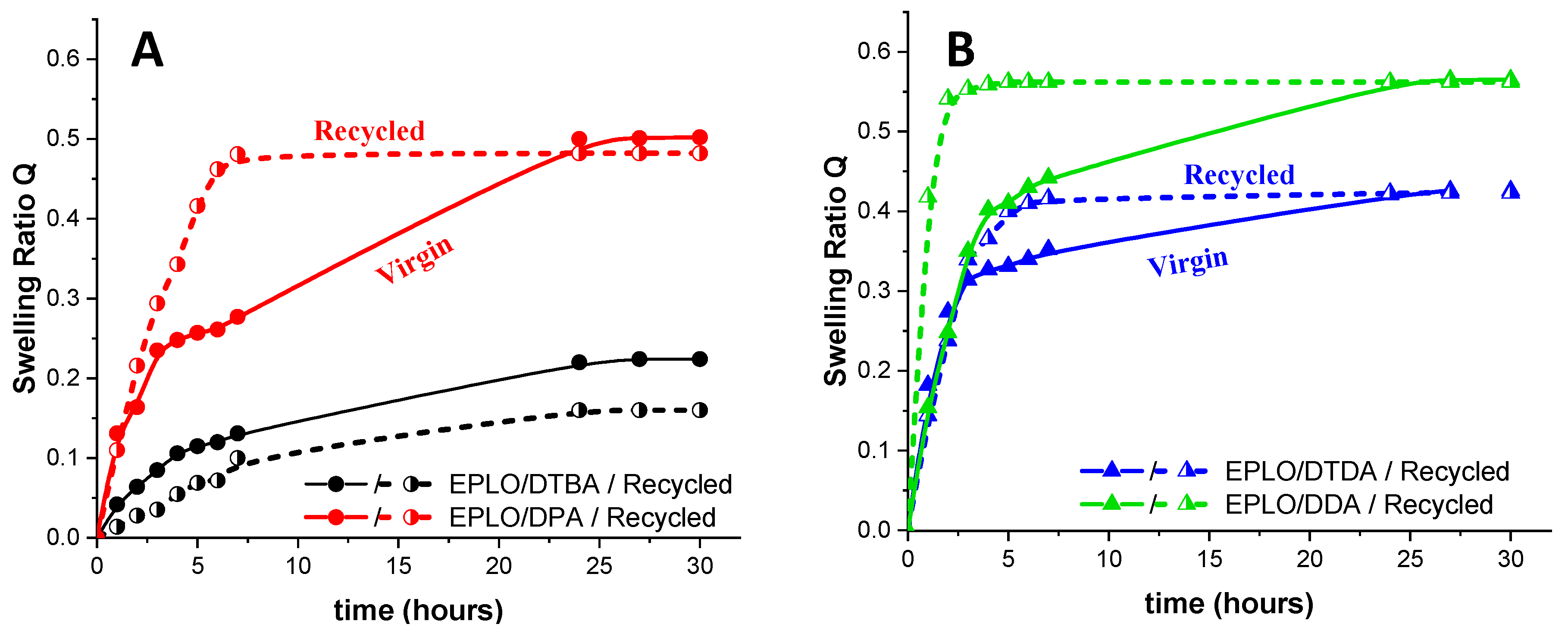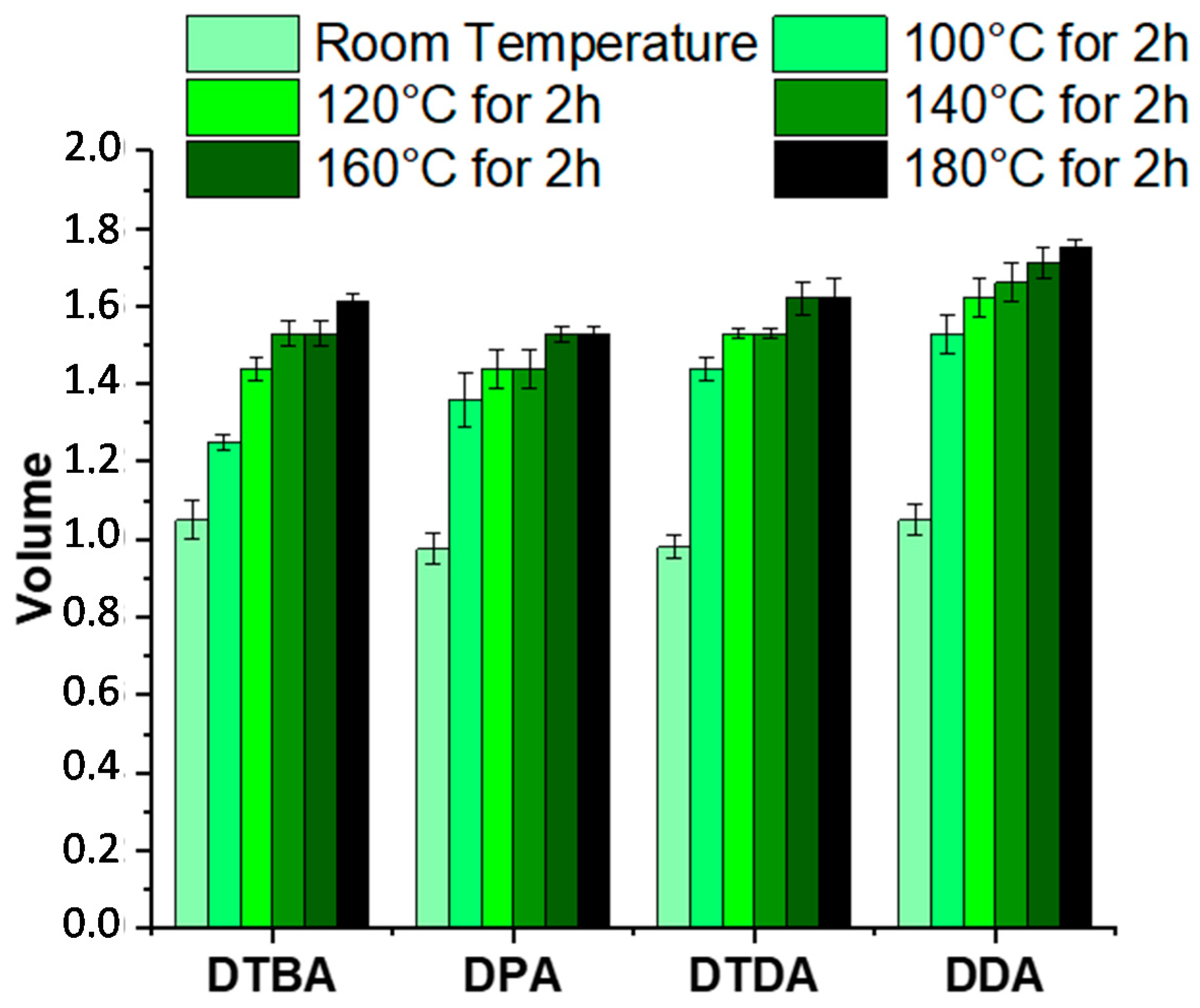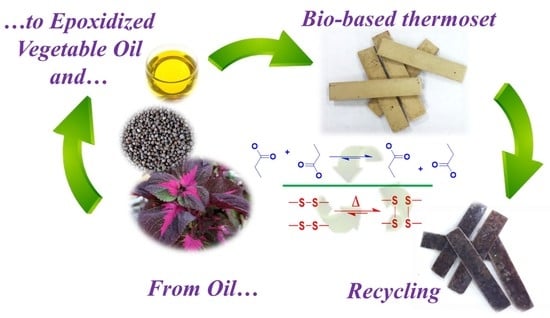Influence of the Presence of Disulphide Bonds in Aromatic or Aliphatic Dicarboxylic Acid Hardeners Used to Produce Reprocessable Epoxidized Thermosets
Abstract
1. Introduction
2. Materials and Methods
2.1. Materials
2.2. Sample Preparation
2.3. Methods
3. Results and Discussion
3.1. Reactivity Studies in Function of the Crosslinker Structure
3.2. Curing Kinetic Analysis
3.3. Thermal and Mechanical Properties of the EVOs-Based Epoxy Resins in Function of the Crosslinker Structures
3.4. Tg Investigation by DSC Analysis of Virgin and Recycled Thermosets
3.5. Dynamic Mechanical Properties
3.6. Thermal Stability
3.7. Solvent Stability
4. Conclusions
Supplementary Materials
Author Contributions
Funding
Conflicts of Interest
Abbreviations
References
- Montarnal, D.; Capelot, M.; Tournilhac, F.; Leibler, L. Silica-like Malleable Materials from Permanent Organic Networks. Science 2011, 334, 965–968. [Google Scholar] [CrossRef]
- Yang, Y.; Pei, Z.; Zhang, X.; Tao, L.; Wei, Y.; Ji, Y. Carbon Nanotube–Vitrimer Composite for Facile and Efficient Photo-Welding of Epoxy. Chem. Sci. 2014, 5, 3486–3492. [Google Scholar] [CrossRef]
- Lu, L.; Pan, J.; Li, G. Recyclable High-Performance Epoxy Based on Transesterification Reaction. J. Mater. Chem. A 2017, 5, 21505–21513. [Google Scholar] [CrossRef]
- De Luzuriaga, A.R.; Martin, R.; Markaide, N.; Rekondo, A.; Cabañero, G.; Rodríguez, J.; Odriozola, I. Epoxy Resin with Exchangeable Disulfide Crosslinks to Obtain Reprocessable, Repairable and Recyclable Fiber-Reinforced Thermoset Composites. Mater. Horiz. 2016, 3, 241–247. [Google Scholar] [CrossRef]
- Rekondo, A.; Martin, R.; de Luzuriaga, A.R.; Cabañero, G.; Grande, H.J.; Odriozola, I. Catalyst-Free Room-Temperature Self-Healing Elastomers Based on Aromatic Disulfide Metathesis. Mater. Horiz. 2014, 1, 237–240. [Google Scholar] [CrossRef]
- Lei, Z.Q.; Xiang, H.P.; Yuan, Y.J.; Rong, M.Z.; Zhang, M.Q. Room-Temperature Self-Healable and Remoldable Cross-Linked Polymer Based on the Dynamic Exchange of Disulfide Bonds. Chem. Mater. 2014, 26, 2038–2046. [Google Scholar] [CrossRef]
- Imbernon, L.; Oikonomou, E.K.; Norvez, S.; Leibler, L. Chemically Crosslinked yet Reprocessable Epoxidized Natural Rubber via Thermo-Activated Disulfide Rearrangements. Polym. Chem. 2015, 6, 4271–4278. [Google Scholar] [CrossRef]
- Chen, M.; Zhou, L.; Wu, Y.; Zhao, X.; Zhang, Y. Rapid Stress Relaxation and Moderate Temperature of Malleability Enabled by the Synergy of Disulfide Metathesis and Carboxylate Transesterification in Epoxy Vitrimers. ACS Macro Lett. 2019, 8, 255–260. [Google Scholar] [CrossRef]
- Martin, R.; Rekondo, A.; de Luzuriaga, A.R.; Cabañero, G.; Grande, H.J.; Odriozola, I. The Processability of a Poly (Urea-Urethane) Elastomer Reversibly Crosslinked with Aromatic Disulfide Bridges. J. Mater. Chem. A 2014, 2, 5710–5715. [Google Scholar] [CrossRef]
- Ma, Z.; Wang, Y.; Zhu, J.; Yu, J.; Hu, Z. Bio-based Epoxy Vitrimers: Reprocessibility, Controllable Shape Memory, and Degradability. J. Polym. Sci. Polym. Chem. 2017, 55, 1790–1799. [Google Scholar] [CrossRef]
- Lu, Y.-X.; Tournilhac, F.; Leibler, L.; Guan, Z. Making Insoluble Polymer Networks Malleable via Olefin Metathesis. J. Am. Chem. Soc. 2012, 134, 8424–8427. [Google Scholar] [CrossRef] [PubMed]
- Liu, T.; Hao, C.; Wang, L.; Li, Y.; Liu, W.; Xin, J.; Zhang, J. Eugenol-Derived Biobased Epoxy: Shape Memory, Repairing, and Recyclability. Macromolecules 2017, 50, 8588–8597. [Google Scholar] [CrossRef]
- Jia, Z.; Zhu, S.; Chen, Y.; Zhang, W.; Zhong, B.; Jia, D. Recyclable and Self-Healing Rubber Composites Based on Thermorevesible Dynamic Covalent Bonding. Compos. Part A Appl. Sci. Manuf. 2020, 129, 105709. [Google Scholar] [CrossRef]
- Ocando, C.; Ecochard, Y.; Decostanzi, M.; Caillol, S.; Avérous, L. Dynamic Network Based on Eugenol-Derived Epoxy as Promising Sustainable Thermoset Materials. Eur. Polym. J. 2020, 135, 109860. [Google Scholar] [CrossRef]
- Cheng, B.; Lu, X.; Zhou, J.; Qin, R.; Yang, Y. Dual Cross-Linked Self-Healing and Recyclable Epoxidized Natural Rubber Based on Multiple Reversible Effects. ACS Sustain. Chem. Eng. 2019, 7, 4443–4455. [Google Scholar] [CrossRef]
- Memon, H.; Wei, Y. Welding and reprocessing of disulfide-containing thermoset epoxy resin exhibiting behavior reminiscent of a thermoplastic. J. Appl. Polym. Sci. 2020, 137, 49541. [Google Scholar] [CrossRef]
- Altuna, F.I.; Pettarin, V.; Williams, R.J.J. Self-Healable Polymer Networks Based on the Cross-Linking of Epoxidised Soybean Oil by an Aqueous Citric Acid Solution. Green Chem. 2013, 15, 3360–3366. [Google Scholar] [CrossRef]
- Supanchaiyamat, N.; Shuttleworth, P.S.; Hunt, A.J.; Clark, J.H.; Matharu, A.S. Thermosetting Resin Based on Epoxidised Linseed Oil and Bio-Derived Crosslinker. Green Chem. 2012, 14, 1759–1765. [Google Scholar] [CrossRef]
- Falco, G.; Sbirrazzuoli, N.; Mija, A. Biomass Derived Epoxy Systems: From Reactivity to Final Properties. Mater. Today Commun. 2019, 21, 100683. [Google Scholar] [CrossRef]
- Di Mauro, C.; Tran, T.N.; Graillot, A.; Mija, A. Enhancing the Recyclability of a Vegetable Oil-Based Epoxy Thermoset through Initiator Influence. ACS Sustain. Chem. Eng. 2020, 8, 7690–7700. [Google Scholar] [CrossRef]
- Tran, T.N.; Di Mauro, C.; Graillot, A.; Mija, A. Chemical Reactivity and the Influence of Initiators on the Epoxidized Vegetable Oil/Dicarboxylic Acid System. Macromolecules 2020, 53, 2526–2538. [Google Scholar] [CrossRef]
- Di Mauro, C.; Genua, A.; Mija, A. Building Thermally and Chemically Reversible Covalent Bonds in Vegetable Oil Based Epoxy Thermosets. Influence of Epoxy–Hardener Ratio in Promoting Recyclability. Mater. Adv. 2020, 1, 1788–1798. [Google Scholar] [CrossRef]
- Di Mauro, C.; Malburet, S.; Graillot, A.; Mija, A. Recyclable, Repairable, and Reshapable (3R) Thermoset Materials with Shape Memory Properties from Bio-Based Epoxidized Vegetable Oils. ACS Appl. Bio Mater. 2020, 3, 8094–8104. [Google Scholar] [CrossRef]
- Di Mauro, C.; Malburet, S.; Genua, A.; Graillot, A.; Mija, A. Sustainable Series of New Epoxidized Vegetable Oil-Based Thermosets with Chemical Recycling Properties. Biomacromolecules 2020, 21, 3923–3935. [Google Scholar] [CrossRef] [PubMed]
- Matějka, L.; Pokorný, S.; Dušek, K. Acid Curing of Epoxy Resins. A Comparison between the Polymerization of Diepoxide-diacid and Monoepoxide-cyclic Anhydride Systems. Die Macromol. Chem. Phys. 1985, 186, 2025–2036. [Google Scholar] [CrossRef]
- Kissinger, H.E. Reaction Kinetics in Differential Thermal Analysis. Anal. Chem. 1957, 29, 1702–1706. [Google Scholar] [CrossRef]
- Ozawa, T. Kinetic Analysis of Derivative Curves in Thermal Analysis. J. Therm. Anal. 1970, 2, 301–324. [Google Scholar] [CrossRef]
- Tran, T.-N.; Di Mauro, C.; Graillot, A.; Mija, A. Monitoring the Structure–Reactivity Relationship in Epoxidized Perilla and Safflower Oil Thermosetting Resins. Polym. Chem. 2020. [Google Scholar] [CrossRef]
- Zhou, F.; Guo, Z.; Wang, W.; Lei, X.; Zhang, B.; Zhang, H.; Zhang, Q. Preparation of Self-Healing, Recyclable Epoxy Resins and Low-Electrical Resistance Composites Based on Double-Disulfide Bond Exchange. Compos. Sci. Technol. 2018, 167, 79–85. [Google Scholar] [CrossRef]
- Ding, C.; Shuttleworth, P.S.; Makin, S.; Clark, J.H.; Matharu, A.S. New Insights into the Curing of Epoxidized Linseed Oil with Dicarboxylic Acids. Green Chem. 2015, 17, 4000–4008. [Google Scholar] [CrossRef]
- Tran, T.-N.; Di Mauro, C.; Malburet, S.; Graillot, A.; Mija, A. Dual Cross-Linking of Epoxidized Linseed Oil with Combined Aliphatic/Aromatic Diacids Containing Dynamic S−S Bonds Generating Recyclable Thermosets. ACS Appl. Bio Mater. 2020. [Google Scholar] [CrossRef]
- Gobin, M.; Loulergue, P.; Audic, J.L.; Lemiègre, L. Synthesis and Characterisation of Bio-Based Polyester Materials from Vegetable Oil and Short to Long Chain Dicarboxylic Acids. Ind. Crops Prod. 2015, 70, 213–220. [Google Scholar] [CrossRef]
- Luo, Y.-R. Comprehensive Handbook of Chemical Bond Energies; CRC Press: Boca Raton, FL, USA, 2007; ISBN 1420007289. [Google Scholar]
- Guo, Z.; Liu, B.; Zhou, L.; Wang, L.; Majeed, K.; Zhang, B.; Zhou, F.; Zhang, Q. Preparation of Environmentally Friendly Bio-Based Vitrimers from Vanillin Derivatives by Introducing Two Types of Dynamic Covalent C-N and S–S Bonds. Polymer 2020, 197. [Google Scholar] [CrossRef]
- Jiang, Y.; Ding, D.; Zhao, S.; Zhu, H.; Kenttämaa, H.I.; Abu-Omar, M.M. Renewable Thermoset Polymers Based on Lignin and Carbohydrate Derived Monomers. Green Chem. 2018, 20, 1131–1138. [Google Scholar] [CrossRef]
- Ma, S.; Kovash, C.S.; Webster, D.C. Effect of Solvents on the Curing and Properties of Fully Bio-Based Thermosets for Coatings. J. Coat. Technol. Res. 2017, 14, 367–375. [Google Scholar] [CrossRef]
- Ma, S.; Liu, X.; Fan, L.; Jiang, Y.; Cao, L.; Tang, Z.; Zhu, J. Synthesis and Properties of a Bio-Based Epoxy Resin with High Epoxy Value and Low Viscosity. ChemSusChem 2014, 7, 555–562. [Google Scholar] [CrossRef] [PubMed]










| EVOs | Crosslinker | Tpeak (°C) | Reaction Interval (°C) | ΔH (J/g) |
|---|---|---|---|---|
| ESFO | DTBA | 159 | 125–195 | 172 ± 2 |
| DPA | 144 | 110–180 | 147 ± 2 | |
| DTDA | 148 | 132–220 | 125 ± 2 | |
| ELO | DTBA | 155 | 118–197 | 197 ± 2 |
| DPA | 138 | 105–181 | 157 ± 2 | |
| DTDA | 143 | 120–218 | 162 ± 2 | |
| EPLO | DTBA | 151 | 118–197 | 207 ± 2 |
| DPA | 134 | 100–180 | 173 ± 2 | |
| DTDA | 141 | 115–205 | 172 ± 2 |
| Cured Resin | Ea (kJ/mol) Kissinger | Ea (kJ/mol) Ozawa | A (s−1) Kissinger |
|---|---|---|---|
| ESFO/DTBA | 79.23 | 86.37 | 1.29 × 106 |
| ELO/DTBA | 77.65 | 84.66 | 1.56 × 106 |
| EPLO/DTBA | 76.72 | 83.65 | 3.95 × 106 |
| ELO/DPA | 81.65 | 88.37 | 1.70 × 107 |
| ELO/DTDA | 108.53 | 115.34 | 3.14 × 1010 |
| ELO/DDA | 80.44 | 87.65 | 1.61 × 106 |
| EVOs | Hardener | tan δ(A) (°C) | E’ Glassy State (A) (MPa) | E’ Rubbery State (A) (MPa) | Crosslinking Density (A) (mmol/cm3) | Density (B) (g/cm3) | |||||
|---|---|---|---|---|---|---|---|---|---|---|---|
| V * | R ** | V * | R ** | V * | R ** | V * | R ** | V * | R ** | ||
| ESFO | DTBA | 68 ± 1 | 79 ± 1 | 780 | 1920 | 3.13 | 0.32 | 0.31 | 0.27 | 1.12 | 1.10 |
| DPA | 43 ± 1 | 45 ± 1 | 3400 | 2810 | 4.88 | 0.19 | 0.50 | 0.11 | 0.91 | 0.98 | |
| DTDA | 0.5 ± 1 | −14 ± 1 | 1710 | 1865 | 2.74 | 0.22 | 0.29 | 0.18 | 1.15 | 1.19 | |
| DDA | −12 ± 1 | −8 ± 1 | 3300 | 1470 | 0.61 | 0.13 | 0.16 | 0.11 | 1.06 | 1.13 | |
| ELO | DTBA | 91 ± 1 | 97 ± 1 | 1560 | 2550 | 8.6 | 8.9 | 1.25 | 0.82 | 1.02 | 1.10 |
| DPA | 62 ± 1 | 79 ± 1 | 2500 | 4000 | 6.54 | 5.81 | 0.68 | 0.58 | 0.94 | 0.99 | |
| DTDA | 10 ± 1 | 15 ± 1 | 5000 | 3640 | 2.55 | 1.60 | 0.34 | 0.33 | 1.17 | 1.15 | |
| DDA | −1 ± 1 | −5 ± 1 | 3800 | 1470 | 3.53 | 0.32 | 0.36 | 0.15 | 1.13 | 1.15 | |
| EPLO | DTBA | 111 ± 1 | 92 ± 1 | 630 | 2400 | 5.98 | 9.15 | 3.00 | 0.82 | 0.99 | 1.02 |
| DPA | 82 ± 1 | 83 ± 1 | 4660 | 5620 | 2.95 | 7.44 | 1.00 | 0.68 | 0.95 | 0.97 | |
| DTDA | 22 ± 1 | 10 ± 1 | 1680 | 4250 | 3.30 | 3.81 | 0.35 | 0.38 | 1.00 | 1.14 | |
| DDA | 12 ± 1 | 0 ± 1 | 5030 | 1780 | 4.14 | 3.69 | 0.43 | 0.40 | 0.96 | 1.19 | |
| EVOs | Hardeners | T5% Virgin (°C) | T5% Recycled (°C) | TS Virgin (°C) | TS Recycled (°C) |
|---|---|---|---|---|---|
| ESFO | DTBA | 265 | 265 | 164 | 160 |
| DPA | 295 | 280 | 175 | 170 | |
| DTDA | 235 | 235 | 167 | 175 | |
| DDA | 270 | 230 | 180 | 172 | |
| ELO | DTBA | 275 | 275 | 167 | 165 |
| DPA | 295 | 295 | 178 | 178 | |
| DTDA | 245 | 245 | 171 | 170 | |
| DDA | 275 | 255 | 179 | 175 | |
| EPLO | DTBA | 255 | 250 | 160 | 161 |
| DPA | 300 | 290 | 176 | 171 | |
| DTDA | 220 | 220 | 164 | 165 | |
| DDA | 260 | 240 | 177 | 173 |
Publisher’s Note: MDPI stays neutral with regard to jurisdictional claims in published maps and institutional affiliations. |
© 2021 by the authors. Licensee MDPI, Basel, Switzerland. This article is an open access article distributed under the terms and conditions of the Creative Commons Attribution (CC BY) license (http://creativecommons.org/licenses/by/4.0/).
Share and Cite
Di Mauro, C.; Mija, A. Influence of the Presence of Disulphide Bonds in Aromatic or Aliphatic Dicarboxylic Acid Hardeners Used to Produce Reprocessable Epoxidized Thermosets. Polymers 2021, 13, 534. https://doi.org/10.3390/polym13040534
Di Mauro C, Mija A. Influence of the Presence of Disulphide Bonds in Aromatic or Aliphatic Dicarboxylic Acid Hardeners Used to Produce Reprocessable Epoxidized Thermosets. Polymers. 2021; 13(4):534. https://doi.org/10.3390/polym13040534
Chicago/Turabian StyleDi Mauro, Chiara, and Alice Mija. 2021. "Influence of the Presence of Disulphide Bonds in Aromatic or Aliphatic Dicarboxylic Acid Hardeners Used to Produce Reprocessable Epoxidized Thermosets" Polymers 13, no. 4: 534. https://doi.org/10.3390/polym13040534
APA StyleDi Mauro, C., & Mija, A. (2021). Influence of the Presence of Disulphide Bonds in Aromatic or Aliphatic Dicarboxylic Acid Hardeners Used to Produce Reprocessable Epoxidized Thermosets. Polymers, 13(4), 534. https://doi.org/10.3390/polym13040534








